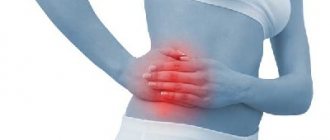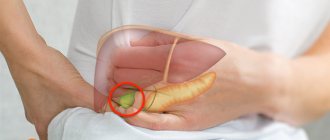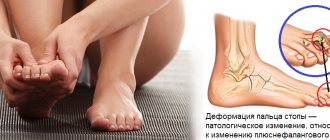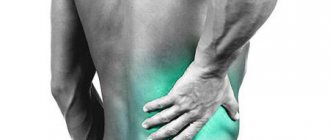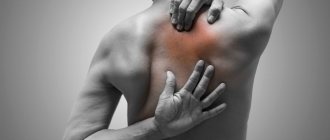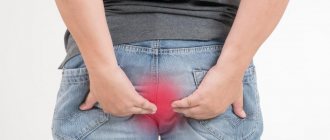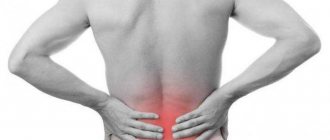Pain on the right under the ribs from behind from the back is an unpleasant symptom that can appear when the functioning of various organs is disrupted. If unpleasant and painful sensations appear in this area, you need the help of a rheumatologist and other specialists who work at the Yusupov multidisciplinary hospital.
Pain in the right hypochondrium can appear not only with disorders of the musculoskeletal system, but also with other systems. At the Yusupov Hospital, high-precision diagnostics are carried out, aimed at collecting the most detailed information about the patient’s current condition.
Causes
Pain syndrome accompanies various pathologies. If there are disturbances in the functioning of the internal organs, back pain on the right may occur. The cause of this symptom can be determined by diagnostic measures, during which the following diseases can be detected:
- chronic or acute pancreatitis;
- oncological diseases of the lungs or bronchi;
- pneumonia;
- pyelonephritis caused by the activity of pathogenic microorganisms. Pain on the right side of the back with this disease intensifies with sudden movements;
- pleurisy, in which the serous membrane covering the lungs becomes inflamed;
- appendicitis;
- formation of a subhepatic abscess;
- urolithiasis disease.
Localized pain on the right side of the back may indicate diseases such as a herniated disc or lumbar osteochondrosis. In addition, this symptom often occurs in women when carrying a child. Specialists at the Yusupov Hospital Therapy Clinic determine the causes of pain and develop a therapy program aimed at eliminating the root causes of discomfort.
Alternative Therapies
Corn silk helps with liver diseases
For various diseases of the gallbladder, the doctor prescribes preparations with immortelle.
The medicinal herb can be brewed with hot water and consumed as regular tea several times a day. The dosage should only be prescribed by a doctor.
For liver diseases, corn silk, rose hips and plantain are prescribed. The same medicinal herbs are prescribed for gallbladder pathologies.
In order to restore liver cells, decoctions prepared from milk thistle or hop cones are prescribed.
Milk thistle restores liver cells
Oat decoction is very effective in most pathological processes. It is recommended to take it after treatment of the liver and gallbladder.
Experts often prescribe mixtures containing knotweed, St. John's wort and chamomile. The duration of treatment is usually one month.
Classification of back pain
It is impossible to independently determine why back pain occurred in the right hypochondrium, therefore, to determine its causes, you should contact the therapy clinic of the Yusupov Hospital and undergo an examination. Classification of pain by location allows specialists to determine which organs are involved in the pathological process:
- pain on the right under the scapula occurs due to a pinched nerve, damage to the serous membrane of the lungs or during an oncological process;
- back pain on the right under the ribs at the back appears when the pancreas or liver is damaged;
- pain in the center of the back is a sign of kidney disease;
- back pain radiates to the right leg due to a hernia or injury, as well as disturbances in the functioning of the urinary system.
However, laboratory results are required to make a definitive diagnosis. Patients of the Yusupov Hospital can take tests and undergo the necessary diagnostic procedures in one day without queues.
Hepatic colic
A symptom of hepatic colic may be aching pain in the left side.
Aching pain on the right is characteristic of liver diseases. This condition is preceded by minor pain, which most patients do not attach importance to. All liver diseases in the initial stages are asymptomatic. For example, hepatitis does not manifest itself in any way; pain appears only when the virus is active. The patient appears:
- Prostration
- Loss of performance
- The skin and whites of the eyes become yellowish
In the future, if this disease is not treated, aching pain will be added to these symptoms.
Symptoms
Back pain in the right hypochondrium is one of the signs of various disorders and diseases. Depending on the cause of its occurrence, the patient may experience other symptoms. The main symptoms accompanying back pain are in the right hypochondrium. Are:
- fever, increased body temperature and chills, indicating the body’s immune system is fighting pathogens;
- attacks of intense headache;
- signs of intoxication of the body;
- decreased blood pressure;
- stool disorders;
- shortness of breath, cough.
When these signs appear, some patients do not consider them serious enough to contact a medical facility. However, in case of diseases of internal organs, self-medication can lead to serious consequences.
At the Yusupov Hospital, patients are treated in comfortable conditions. A friendly attitude towards each client, high professionalism of employees and the use of modern technologies and techniques allow us to provide medical care that meets international requirements. The Yusupov Hospital does not refuse treatment to patients in serious condition; they are offered emergency hospitalization and high-quality treatment.
Cholecystitis
This disease is associated with a delay in the outflow of bile from the gallbladder along the biliary tract. Sharp pain from the right hypochondrium may indicate an attack of cholecystitis. More often this happens at night.
The muscle tone of the bladder increases, provoking its numerous contractions. The patient feels sharp and severe pain. The pain is usually short-lived, but the person experiences stress that turns into neuroses.
The disease develops as a result of cholelithiasis, slowly moving from the acute form to the chronic stage. The walls of the bladder are damaged due to the pressure of stones on it, thicken and become covered with ulcers, which subsequently scar. Stagnation of bile occurs, accompanied by:
- Mild pain
- Nausea
- Bloating
- Vomiting
The pain may worsen when eating fatty or fried foods.
Muscle pain
People of all ages experience muscle pain in the back. The most common cause of pain is diseases of the spine. So, with osteochondrosis or scoliosis, compression of the muscles located nearby occurs. As the disease progresses, back pain on the right under the ribs may intensify and hinder movement.
One of the methods for eliminating muscle pain in the back is physical therapy. Specialists at the Yusupov Hospital Rehabilitation Center select exercises in such a way as to strengthen the muscle corset and reduce the load on the spine, as well as eliminate the resulting pathology. Physiotherapeutic procedures in combination with massages are highly effective for back pain in the right hypochondrium.
When does a person need help?
The ambulance is called in terminal conditions:
- Unexpectedly, there was severe pain in the side area; the pain lasted for 38–45 minutes.
- The person vomits bloody substances profusely, feels bitterness in the mouth, and hyperthermia appears.
- Pain increases during physical activity.
- The pain syndrome suddenly disappeared.
- Antispasmodic drugs do not help eliminate pain.
- Hematuria is observed.
- The patient became worse and became confused.
Diagnostics
Rheumatologists at the Yusupov Hospital and other specialists draw patients’ attention to the fact that pain in the ribs on the right side of the back can be a sign of serious disorders, therefore, to establish its causes, a set of diagnostic measures is carried out using European equipment:
- study of symptoms and complaints of patients;
- physical examination of the patient;
- passing biochemical and clinical tests;
- MRI and CT;
- ultrasonography;
- stool analysis;
- performing bronchoscopy.
The diagnostic center of the Yusupov Hospital is equipped with European equipment, which allows obtaining high-precision research results. Cooperation with leading research centers allows us to perform rare and complex studies, so the specialists of the therapy clinic provide assistance even to those patients who were abandoned in other medical institutions.
After load
Unpleasant sensations in the form of nagging or stabbing pain occur after physical exertion in people with hepatitis, cirrhosis, or congestive liver. After shaking or physical exertion, an attack of calculous cholecystitis may occur. Also, periodic pain during exercise appears in patients with myositis, intercostal neuralgia, osteochondrosis, rib fractures, and vena cava thrombosis.
Treatment
Pain in the right hypochondrium, radiating to the back, can bother people of all ages, while some patients do not perceive it as a serious symptom. If you seek medical help early, it is possible to stop the pathological process at a stage when it does not cause consequences.
Specialists at the therapy clinic, in particular rheumatologists, treat back pain in the right hypochondrium and the root causes of this symptom. Patients who experience back pain in the rib area on the right may be prescribed complex treatment depending on the type of disorder. Comprehensive therapy programs include the following activities:
- taking medications to relieve pain and inflammation;
- use of physiotherapeutic techniques;
- massages;
- drawing up a nutrition program;
- regular physical therapy classes under the guidance of experienced instructors.
Pre-registration by phone allows you to optimize the work of the Yusupov Hospital and create the most comfortable conditions for patients. Contact the Yusupov Hospital staff by phone and choose a convenient time to visit a specialist.
What changes occur in the hypochondrium during the act of breathing?
The diaphragm, which serves as the upper border of the hypochondrium, is an active participant in the act of breathing. It, together with the chest, provides respiratory movements. The goal is to create negative pressure in the pleural cavity so that the lung tissue stretches as much as possible and air enters it during inspiration.
The anatomical structures of the “sigh”, in addition to the diaphragm, include the external intercostal muscles. When contracting, the ribs move upward, the chest increases in volume, especially in the lower sections. This is facilitated by additional contraction of the diaphragm. As you inhale, it flattens and descends towards the abdominal cavity.
At rest and during exhalation, the dome moves towards the chest. In people of different build types, it is possible to breathe predominantly through thoracic breathing (more typical for women, depending on the work of the intercostal muscles) or abdominal breathing, when the main participant is the diaphragm.
As it moves, it simultaneously pulls the abdominal organs with it. The liver is “attached” to the inside of the diaphragm by a powerful falciform ligament. Dense connective tissue fibers attach the gallbladder to the lower surface of the right lobe of the liver. Sometimes the cecum with a vermiform appendix and loops of the small intestine are located here.
During exhalation, the internal intercostal muscles and the abdominal wall are actively engaged. They apply pressure from below on the organs located in the upper floor of the peritoneum and the diaphragm in order to reduce the volume of the chest. By contracting simultaneously with the abdominal muscles, the diaphragm increases pressure in the abdominal cavity.
The respiratory center of the medulla oblongata regulates the sequence of these movements, transmitting nerve signals through the spinal canals.
The greater the resistance of the lung tissue (loss of elasticity during sclerosis, inflammation), the more the muscles tense. Their work increases significantly with an increase in breathing frequency and physical activity.
With forced breathing, the muscles of the neck, back and chest are involved in the process
